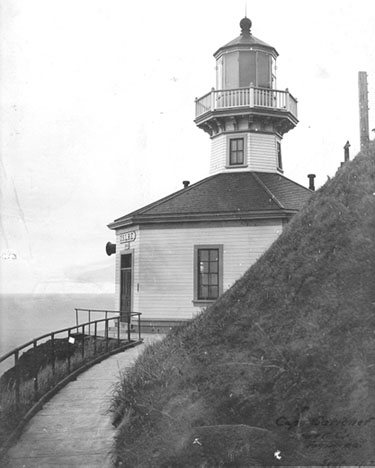 | ||||||


Historic Light Station Information
& Photography
CAPE SARICHEF LIGHT-ALASKA
Location: UNIMAK PASS THRU ALEUTIAN ISLANDS
Station Established: 1904
Year Current Tower(s) First Lit: 1950
Operational? NO
Automated? YES 1979
Deactivated: 1979
Foundation Materials:
Construction Materials: REINFORCED CONCRETE
Tower Shape: HEXAGONAL
Markings/Pattern: ART MODERN
Relationship to Other Structure: INTEGRAL
Original Lens: THIRD ORDER 1904
Historical Information:
- This was the most westerly lighthouse in North America. almost 2,100 miles farther west on the map than San Francisco. The lighthouse first established in 1904 to mark the northern entrance of Unimak Pass. All original bids for construction were rejected as too expensive. Construction was completed in October of 1903 but the lantern had not yet arrived. The third order Fresnel fixed white light was first lit on July 1, 1904 for a total cost of $80,000. The original light was on a wood tower on an octagonal wood building 45 feet high. The light was 126 feet above the sea.
- Once noted as the most isolated station in America sometimes mail was not received for months at a time. The station was shut down from December 1st thru March 1st because the Bering Sea was frozen. The civilian keepers were granted one year's leave each four years. Although quarters were originally provided for them, families were not permitted to live at this and Scotch Cap Light, because of their isolation. Coast Guard personnel that served at the light served a year at a time at this isolated location. At the end of his year's tour each man was transferred to a new duty station.
- In 1904 storms damaged a boat house, engine house and derrick located on a reef near the light. All had to be replaced.
- Following the disastrous tsunami at Scotch Cap Light Station in 1946, Cape Sarichef light was rebuilt and then relit in 1950. The new light was a 375-millimeter electric white light of 9,000 candlepower that flashed for 25 seconds and was eclipsed for 5 seconds. The crew of the CGC Northwind "razed the old lighthouse building by burning."
- In 1979 the station was discontinued, including the termination of the radiobeacon, fog signal and emergency light and a steel skeleton tower was erected adjacent to the old tower. The new light was automated and the property was turned over to the U.S. Fish and Wildlife Service. The light's characteristic was a flashing white light every six seconds and had an eight mile range.
- Building was demolished by the Coast Guard in 1999.

